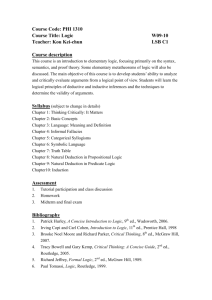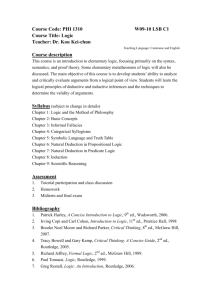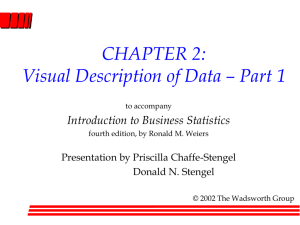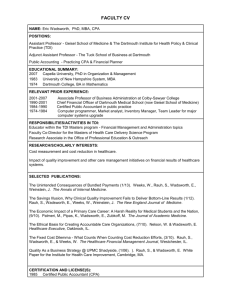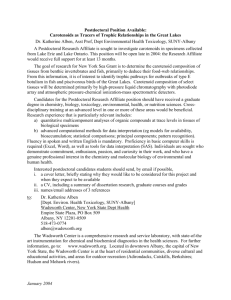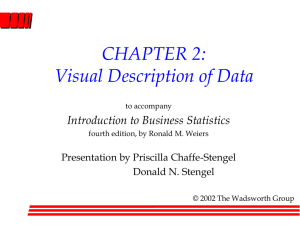CHAPTER 8 Estimation from Sample Data
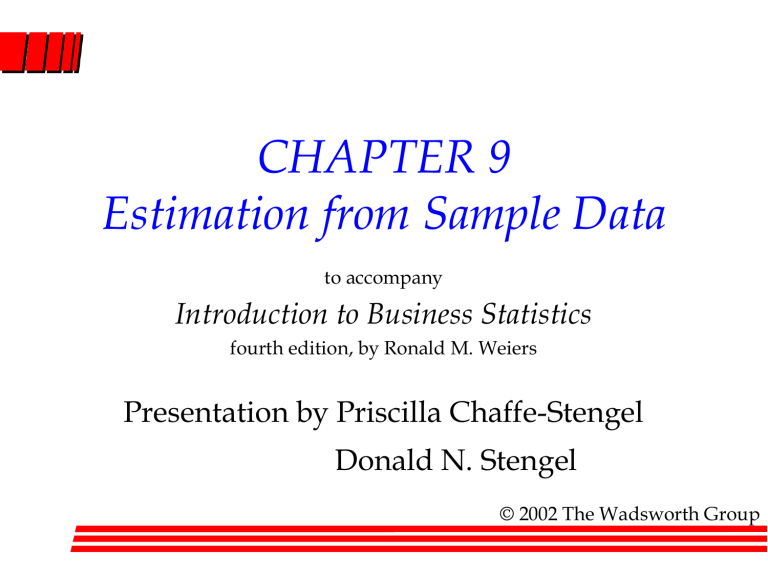
CHAPTER 9
Estimation from Sample Data to accompany
Introduction to Business Statistics fourth edition, by Ronald M. Weiers
Presentation by Priscilla Chaffe-Stengel
Donald N. Stengel
© 2002 The Wadsworth Group
Chapter 9 - Learning Objectives
• Explain the difference between a point and an interval estimate.
• Construct and interpret confidence intervals:
– with a z for the population mean or proportion.
– with a t for the population mean.
• Determine appropriate sample size to achieve specified levels of accuracy and confidence.
© 2002 The Wadsworth Group
Chapter 9 - Key Terms
• Unbiased estimator
• Point estimates
• Interval estimates
• Interval limits
• Confidence coefficient
• Confidence level
• Accuracy
• Degrees of freedom (df)
• Maximum likely sampling error
© 2002 The Wadsworth Group
Unbiased Point Estimates
Population Sample
Parameter
• Mean, µ
Statistic x
Formula x =
n x i
• Variance, s 2 s 2 s 2
=
( x n i
–
–
1 x ) 2
• Proportion, p p p = x successes n trials
© 2002 The Wadsworth Group
Confidence Interval: µ, s Known
ASSUMPTION: s = population standard infinite population deviation
n = sample size
z = standard normal score for area in tail = a /2 a 2 a a 2 z : x : x
– z
–
z s n
0 x x
+
+ z
z s n
© 2002 The Wadsworth Group
Confidence Interval: µ, s Unknown
ASSUMPTION:
s = sample standard Population deviation
n = sample size
t = t-score for area in tail = a /2
df = n – 1 a 2 a approximately normal and infinite a 2 t : x : x
– t
– t s n
0 x x
+
+ t
t s n
© 2002 The Wadsworth Group
Confidence Interval on p where p = sample proportion ASSUMPTION:
n = sample size n•p 5,
z = standard normal score for area in tail = a /2
n•(1–p) 5, and population infinite a 2 a a 2 z : p : p
– z
– z p ( 1 – p ) n
0 p
+ z p
+ z
p ( 1 – p ) n
© 2002 The Wadsworth Group
Converting Confidence Intervals to
Accommodate a Finite Population
• Mean: or x
z a
2
s n
N
N
– n
– 1
x
t a
2
s n
N
N
– n
–
1
• Proportion: p
z a
2
p ( 1
– n p ) N
N
– n
– 1
© 2002 The Wadsworth Group
Interpretation of
Confidence Intervals
• Repeated samples of size n taken from the same population will generate (1– a )% of the time a sample statistic that falls within the stated confidence interval.
OR
• We can be (1– a )% confident that the population parameter falls within the stated confidence interval.
© 2002 The Wadsworth Group
Sample Size Determination for µ from an Infinite Population
• Mean: Note s is known and e, the bound within which you want to estimate µ, is given.
– The interval half-width is e, also called the maximum likely error: e
= z
s n
– Solving for n, we find: n
= z
2 s 2 e
2
© 2002 The Wadsworth Group
Sample Size Determination for µ from a Finite Population
• Mean: Note s is known and e, the bound within which you want to estimate µ, is given.
n = e 2 z 2 s 2
+ s 2
N where n = required sample size
N = population size
z = z-score for (1– a )% confidence
© 2002 The Wadsworth Group
Sample Size Determination for from an Infinite Population p
• Proportion: Note e, the bound within which you want to estimate p , is given.
– The interval half-width is e, also called the maximum likely error: e
= z
p ( 1 n
– p )
– Solving for n, we find: n
= z
2 p ( 1 – e
2 p )
© 2002 The Wadsworth Group
Sample Size Determination for from a Finite Population p
• Mean: Note e, the bound within which you want to estimate µ, is given.
n
= p (1– p ) e
2 z 2
+ p (1– p )
N where n = required sample size
N = population size
z = z-score for (1– a )% confidence
p = sample estimator of p
© 2002 The Wadsworth Group
An Example: Confidence Intervals
• Problem: An automobile rental agency has the following mileages for a simple random sample of
20 cars that were rented last year. Given this information, and assuming the data are from a population that is approximately normally distributed, construct and interpret the 90% confidence interval for the population mean.
55 35 65 64 69 37 88
39 61 54 50 74 92 59
38 59 29 60 80 50
© 2002 The Wadsworth Group
A Confidence Interval Example, cont.
• Since s is not known but the population is approximately normally distributed, we will use the t-distribution to construct the 90% confidence interval on the mean.
x
=
57 .
9 , s
=
17 .
384 df
=
20 – 1
=
19 , a
/ 2
=
0 .
05
So, t
=
1 .
729 a 2 a a 2 x
t
s n
57 .
9
1 .
729
17 .
384
20
57 .
9
6 .
721
( 51 .
179 , 64 .
621 ) t : x : x
– t
– t s n
0 x x
+
+ t
t s n
© 2002 The Wadsworth Group
A Confidence Interval Example, cont.
• Interpretation:
– 90% of the time that samples of
20 cars are randomly selected from this agency’s rental cars, the average mileage will fall between 51.179 miles and
64.621 miles.
© 2002 The Wadsworth Group
An Example: Sample Size
• Problem: A national political candidate has commissioned a study to determine the percentage of registered voters who intend to vote for him in the upcoming election. In order to have 95% confidence that the sample percentage will be within
3 percentage points of the actual population percentage, how large a simple random sample is required?
© 2002 The Wadsworth Group
A Sample Size Example, cont.
• From the problem we learn:
– (1 – a ) = 0.95, so a = 0.05 and a /2 = 0.025
– e = 0.03
• Since no estimate for p is given, we will use 0.5 because that creates the largest standard error.
n
= z
2
( p )( 1 – e
2 p ) = 1 .
96
2
( 0 .
5 )( 0 .
5 )
( 0 .
03 )
2
=
1 , 067 .
1
To preserve the minimum confidence, the candidate should sample n = 1,068 voters.
© 2002 The Wadsworth Group
